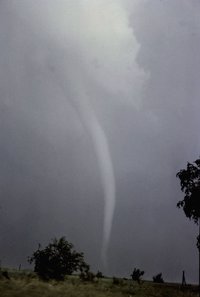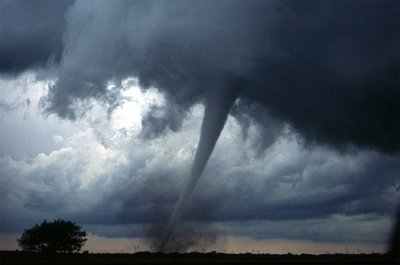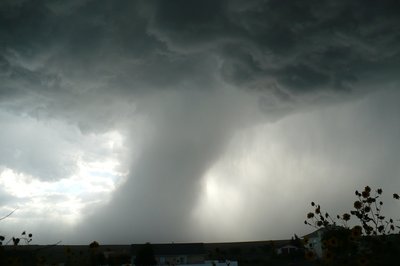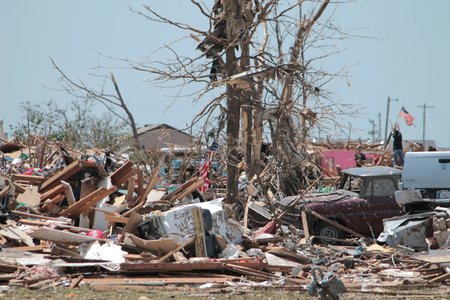Tornado
|
|
A tornado is a violent windstorm characterized by a twisting, funnel-shaped cloud. The word "tornado" comes from the Spanish or Portuguese verb tornar, meaning "to turn." Tornadoes form in storms all around the world, most famously in a broad area of the American Midwest and South known as Tornado Alley. Although in pure number of incidences, the United States experiences more tornadoes than any other country, the United Kingdom is the most proportionally tornado-prone country for its size. Some common, related slang terms are: twister, whirlwind, wedge, funnel, gustnado, landspout, willy-willy, or rope. Cyclone is also an old-fashioned term for a tornado.
| Contents |
Tornado formation
Tornadoes develop from severe thunderstorms, usually spawned from squall lines and supercell thunderstorms, though they sometimes happen as a result of a hurricane. They are believed to be produced when cool air overrides a layer of warm air, forcing the warm air to rise rapidly, though tornadoes over water (waterspouts) frequently are observed forming in the absence of convection or apparent strong surface temperature differences. Tornadoes, lightning, and sometimes hail are associated with thunderstorms. Many tornadoes appear at the tail end of mesocyclones. On weather radar screens, a characteristic "hook echo" marks the area where tornadoes are likely to exist.
Exactly how tornadoes form is complex and not fully understood. When thunderstorms develop, an increase in wind speed and/or a large change in direction with height ("wind shear") produces a horizontal, spinning area of air. The strong updrafts within the thunderstorm can draw this area of rotation up from horizontal to vertical. Towards the end of this area of rotation (the mesocyclone) is often a lower area of rain-free cloud and can be seen as a rotating "wall cloud". If the rotation intensifies, funnel clouds can develop within this area and form tornadoes when they reach the ground. Why the rotation can intensify and form tornadoes is not understood.
Tornadoes normally rotate in a cyclonic direction as the warm air thunderstorms usually form in sweeps north and jet streams come from the west, creating a situation in which the storms rotate. In the northern hemisphere, this rotation is counterclockwise, and in the southern hemisphere, clockwise. The tornadoes usually rotate the same way. Sometimes opposite direction swirls develop under a thunderstorm. And about 1 in 100 tornadoes rotate in an anti-cyclonic direction.
Tornado damage to man-made structures is the result of high wind velocity and the associated wind-blown debris. Tornadic winds have been measured well in excess of 300 mph (480 km/h). Tornado season in North America is generally March through October, although tornadoes can occur at any time of year. They tend to occur in the afternoons and evenings: over 80 percent of all tornadoes strike between noon and midnight.
Tornadoes can be nearly invisible, marked only by swirling debris at the base of the funnel. While tornadoes are invisible at night, some nocturnal tornadoes have been observed glowing diffusely due to lightning activity. Verified observations by Hall and others suggest a cellular structure inside tornadoes. Some tornadoes are composed of several mini-funnels. A tornado must by definition have both ground and cloud contact.
Waterspouts
Main article: Waterspout
A waterspout is a tornado that occurs over water, usually not in association with a supercell thunderstorm. Although waterspouts are always tornadoes by definition, they are not counted in official tornado records unless they hit land. They are smaller and weaker than the most intense Great Plains tornadoes, but still can be quite dangerous. Waterspouts can overturn small boats, damage ships, do significant damage when hitting land, and kill people. [1] (http://www.spc.noaa.gov/faq/tornado/) USA Today article on waterspouts (http://www.usatoday.com/weather/wspouts.htm)
Tornado climatology
The United States experiences by far the most tornadoes of any country, and has also suffered the most intense ones. However, tornadoes do occur throughout the world; the most tornado-prone region of the world, as measured by the number of tornadoes per unit area, is the United Kingdom, especially England [2] (http://www.torro.org.uk/severeweather/tornadofaqs.htm). New Zealand, Bangladesh and portions of Uruguay also have pockets of strong tornadic activity. Tornadoes have recently hit parts of Germany in 2003 and Pakistan in 2001 as well. The U.S. state which has the highest number of tornadoes per unit area is Florida, although most of the tornadoes in Florida are either F0, F1, or waterspouts.
In Canada, an average of 80 tornadoes occur annually, killing 2, injuring 20 and causing tens of millions of dollars in damage. The last killer tornado in Canada struck Pine Lake, Alberta on July 14, 2000, killing 11.
On average, the United States experiences 100,000 thunderstorms each year, resulting in over 1,000 tornadoes and approximately 50 deaths per year. The deadliest US tornado on record is the March 18, 1925 Tri-State Tornado that went across southeastern Missouri, southern Illinois, and southern Indiana, killing 695 people. More than six tornadoes in one day is considered a tornado outbreak. The biggest tornado outbreak on record—with 148 tornadoes, including six F5 and 23 F4 tornadoes—occurred on April 3, 1974. It is dubbed the Super Outbreak. Another such significant storm system was the Palm Sunday Tornado Outbreak which affected the United States Midwest on April 11, 1965.
Observations
The intensity of tornadoes is given by the Fujita-Pearson Tornado Scale (also known simply as Fujita scale). The intensity can be derived directly with high resolution Doppler radar wind speed data, or empirically derived from structural damage compared to engineering data. Also, note that intensity does not refer in any way to the size, or width, of a tornado.
Trained weather spotters are often on alert to look for tornadoes and notify local weather agencies when severe weather is occurring or predicted to be imminent. In the United States, skywarn spotters, often local sheriff's deputies, fulfill this role. Additionally, some individuals, known as storm chasers, enjoy pursuing thunderstorms and tornadoes to explore their many visual and scientific aspects.
Attempts have been made by storm chasers to drop probes in the path of oncoming tornadoes in an effort to analyze the interior of the storms, but only about five drops have been successful since around 1990.
Tornado characteristics
No two tornadoes look exactly alike. Nor have any two tornadoes behaved exactly the same. There are true incidents of tornadoes repeatedly hitting the same town several years in a row. But forecasting the exact position a tornado will strike at a certain time is nearly impossible.
Not every thunderstorm, supercell, squall line, or hurricane will produce a tornado. Luckily, it takes exactly the right combination of atmospheric variables (wind, temperature, pressure, humidity, etc) to spawn even a weak tornado. On the other hand, roughly 1,000 tornadoes a year are reported in the contiguous US.
Of all tornadoes formed in the US, F0 and F1 tornadoes account for a large percentage of occurrences. On the other end of the scale, the massively destructive F5 tornadoes account for less than 1% of all tornadoes in the US.
Even though no two tornadoes are exactly alike, they always have the same general characteristics that classify them as tornadoes. First, a tornado is a microscale rotating area of wind. A thunderstorm can rotate, but that does not mean it is a tornado. Secondly, the vortex, rotating wind, must be attached to a convective cloud base, and be in contact with the ground. Some of those are thunderstorms embedded in squall lines, supercell thunderstorms, and also not to exclude the outer fringes of landfalling hurricanes. Third, a spinning vortex of air must have a wind speed above a certain rate to be classified by the Fujita scale as a tornado.
Tornado awareness and safety
According to Environment Canada, the chances of being killed by a tornado are 12 million to 1 (12,000,000:1). One may revise this yearly and/or regionally, but the probability may be factually stated to be low. Tornadoes do cause millions of dollars in damage, both economic and physical, displacement, and many injuries every year.
Each time tornado season comes around, schools and media outlets in tornado-prone areas spend time educating the public about the dangers and what can be done to improve the chances of surviving a storm. In the United States, citizens are often advised to purchase NOAA Weather Radios. They are relatively inexpensive devices costing as little as $20 in U.S. currency, which will activate whenever the National Weather Service issues severe weather warnings. Warnings are also carried on radio and television, and most communities have civil defense sirens that will activate when severe weather is believed to be approaching.
When tornado warnings are issued, members of the public are advised to get into sheltered areas. In most buildings, it is recommended to seek shelter in a central, windowless room or corridor, below ground if possible. If a tornado does strike a building, it can cause debris to rain down on people inside, so it is advisable to crouch under strong beams, in doorways, or under strong furniture. However, light structures such as mobile homes are in severe danger when tornadoes and strong winds appear. Residents of such structures are advised to evacuate them whenever severe weather is imminent and seek shelter in sturdier buildings, whether they are designated shelters or the homes of nearby friends. Storm cellars are also common places of refuge in some regions.
Vehicles are extremely dangerous in a tornado. If the tornado is visible, far away, and the traffic is light, you may be able to drive out of its path by moving at right angles to the tornado. Otherwise, park the vehicle as quickly and safely as possible -- out of the traffic lanes (it is safer to get the vehicle out of mud later if necessary than to cause a crash) and seek shelter in a sturdy building or ditch. You should not, under any circumstances, stay in a vehicle if the vehicle is in or near the path of a tornado. Vehicles are easily tossed around by the extreme winds created by a tornado.
Some people take shelter underneath bridge overpasses during storms, but they are not considered a safe place to take shelter. The National Weather Service office based in Norman, Oklahoma has created a presentation discussing the use of bridges as protection during the Oklahoma Tornado Outbreak that occurred on May 3, 1999 in the region of Oklahoma City where tornadoes passed over three different bridges—at least one person was killed in each instance. Bridges vary in construction, and many do not provide any significant protection from the wind and flying debris.
Many misconceptions, and science fiction, concerning tornado formation crop up from time to time. See Tornado myths.
Further safety information is available via the "External links" section below.
See also
- Curl
- Dust devil
- Funnel cloud
- Emergency Alert System
- Fire tornado
- Waterspout
- List of tornadoes and tornado outbreaks
- Tropical cyclone
- Tornado records
- Sudden downturn of F5 tornadoes Talks about the dry spell of F5 tornadoes we've seen this century.
- List of F5 tornadoes
References
- Thomas P. Grazulis; Significant Tornadoes: 1860 - 1991; Environmental Films; ISBN 1879362007 (hardcover, 1993)
External links
- Tornado Frequently Asked Questions (http://www.spc.noaa.gov/faq/tornado/). National Weather Service Storm Prediction Center.
- USA Today article on waterspouts (http://www.usatoday.com/weather/wspouts.htm)
- Tornadoes in Kansas (http://www.americaslibrary.gov/cgi-bin/page.cgi/es/ks/tornado_1). Library of Congress, America's Story.
- F3 and F4 tornadoes in Germany since 1900 (http://wetterchronik.de/english/tornadogeruecht.htm)
- Tornado damage (http://lcweb2.loc.gov/cgi-bin/query/S?pp/pan:@field(SUBJ+@od1(Tornadoes+))) (in 1899; archived panoramic photographs)
- Tornado images (http://www.spc.noaa.gov/faq/tornado/torscans.htm) (Public Domain)
- The Tornado Project Online! (http://www.tornadoproject.com/)
- TorDACH: Centre of Competence for Severe Local Storms in D, A, CH (http://www.tordach.org)
- Highway Overpasses as Tornado Shelters: Fallout from the May 3, 1999 Tornado Outbreak (http://www.srh.noaa.gov/oun/papers/overpass.html). National Weather Service, Norman, Oklahoma.
- An F3 tornado hit Acht (Eifel, Germany) on June 10th 2003 (http://wetterchronik.de/english/unweifel10juni2003b.htm)
- Vehicle damage by a tornado (http://www.spc.noaa.gov/misc/spencer/lsdv4.jpg)
- National Severe Storms Laboratory, Norman, Oklahoma: Tornado research and education (http://www.nssl.noaa.gov/researchitems/tornadoes.shtml)
- The Tornado and Storm Research Organisation (http://www.torro.org.uk/)
- Chasing Tornadoes (National Geographic Magazine) (http://magma.nationalgeographic.com/ngm/0404/feature1/index.html)




